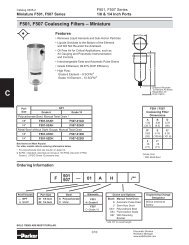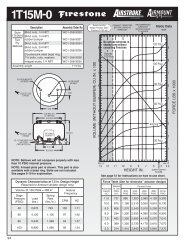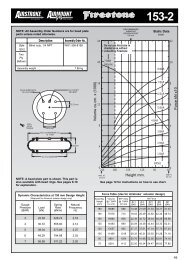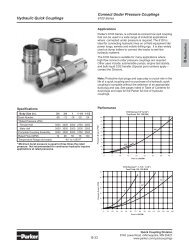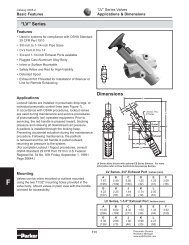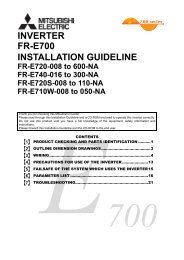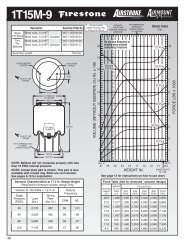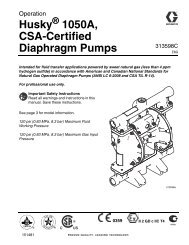FR-F700 INSTRUCTION MANUAL (BASIC) - MRO Stop
FR-F700 INSTRUCTION MANUAL (BASIC) - MRO Stop
FR-F700 INSTRUCTION MANUAL (BASIC) - MRO Stop
- No tags were found...
Create successful ePaper yourself
Turn your PDF publications into a flip-book with our unique Google optimized e-Paper software.
Check first when you have troubles5.6 Check first when you have troublesPOINTIf the cause is still unknown after every check, it is recommended to initialize the parameters (initial value) then resetthe required parameter values and check again.5.6.1 Motor does not start1) Check the value of Pr. 0 Torque boost setting. (Refer to page 56)2) Check the main circuit.Check that a proper power supply voltage is applied (operation panel display is provided).Check that the motor is connected properly.Check that the jumper across P/+-P1 is connected.3) Check the input signalsCheck that the start signal is input.Check that both the forward and reverse rotation start signals are not input simultaneously.Check that the frequency setting signal is not zero. (When the frequency command is 0Hz and thestart command is entered, FWD or REV LED on the operation panel flickers.)Check that the AU signal is on when terminal 4 is used for frequency setting signal.Check that the output stop signal (MRS) or reset signal (RES) is not on.Check that the CS signal is not OFF with automatic restart after instantaneous power failure functionis selected (Pr. 57 ≠ "9999").Check that the sink or source jumper connector is fitted securely. (Refer to page 22.)Check that the voltage/current input switch is correctly set for analog input signal (0 to 5V/0 to 10V, 4to 20mA).4) Check the parameter settingsCheck that Pr. 78 Reverse rotation prevention selection is not selected.Check that the Pr. 79 Operation mode selection setting is correct.Check that the bias and gain (calibration parameter C2 to C7) settings are correct.Check that the Pr. 13 Starting frequency setting is not greater than the running frequency.Check that frequency settings of each running frequency (such as multi-speed operation) are not zero.Check that especially the Pr. 1 Maximum frequency setting is not zero.Check that the Pr. 15 Jog frequency setting is not lower than the Pr. 13 Starting frequency setting.Check that the operation location by Pr. 550 and Pr. 551 is correct.5) Inspection of loadCheck that the load is not too heavy.Check that the shaft is not locked.5.6.2 Motor generates abnormal noiseNo carrier frequency noises (metallic noises) are generated.Soft-PWM control to change the motor tone into an unoffending complex tone is factory-set to validby Pr.72 PWM frequency selection.Adjust Pr.72 PWM frequency selection to change the motor tone.(When operating the inverter with the carrier frequency of 3kHz or more set in Pr. 72, the carrierfrequency will automatically decrease if the output current of the inverter exceeds the value inparenthesis of the rated output current on page 118. This may cause the motor noise to increase. Butit is not a fault.)Check for any mechanical looseness.Contact the motor manufacturer.TROUBLESHOOTING55.6.3 Motor generates heat abnormallyIs the fan for the motor is running? (Check for accumulated dust.)Check that the load is not too heavy. Lighten the load.Check that the inverter output voltages (U, V, W) balanced.Check that the Pr.0 Torque boost setting is correct.Was the motor type set? Check the setting of Pr. 71 Applied motor.107



